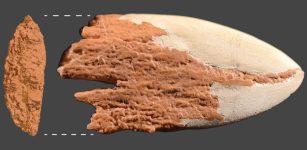Norwegian Vikings Were Much More Violent Than Their Danish Counterparts, New Study Reveals
Jan Bartek - AncientPages.com - A recent study has challenged the long-held assumption that rates of violence in Viking Age Norway and Denmark were comparable. The research, published in the Journal of Anthropological Archaeology, presents evidence suggesting that interpersonal violence was significantly more prevalent in Norway during this period.
The study was conducted by an interdisciplinary team of researchers, including Dr. David Jacobson, a sociologist from the University of South Florida, and colleagues from Norway and Germany. Their findings are based on a comprehensive analysis of skeletal trauma rates and the prevalence of weaponry in archaeological contexts.
Credit: Adobe Stock - Sunshower Shots
The research methodology incorporated a multifaceted approach, combining archaeological evidence, sociological analysis, osteological examination, and the study of runestones. The team's varied data sources revealed key differences in violence, social hierarchies, and authority between the two regions. This investigation offers new insights into the distinct social structures and experiences of violence in Viking Age Norway and Denmark, contributing to a more nuanced understanding of their societal dynamics.
"The interdisciplinary approach taken in this study shows us how social and political patterns can be revealed, even when there are a paucity of written sources," Jacobson said.
Violence During The Viking Age In Norway
An analysis of skeletal remains from Viking Age Norway and Denmark has revealed significant findings regarding the prevalence of violence during this period. The study indicates that 33% of the Norwegian skeletons exhibited healed injuries, suggesting that violent encounters were not uncommon. Furthermore, 37% of the skeletons displayed evidence of lethal trauma, underscoring the frequent and often fatal use of weapons in Norway during this era.
A skull displaying blunt force trauma with radiating lines. Credit: Lisa Mariann Strand
A noteworthy aspect of the Norwegian findings was the presence of weapons, particularly swords, accompanying skeletons in burial sites. The research identified more than 3,000 swords from the Late Iron Age and Viking periods in Norway, starkly contrasting to the mere dozens found in Denmark. These discoveries suggest that weapons played a crucial role in Norwegian Viking identity and social hierarchy, further emphasizing the culture's significant association with violence.
Violence During The Viking Age In Denmark
The archaeological evidence from Denmark reveals a distinct societal structure compared to other Viking territories. Danish society exhibited a more centralized organization characterized by well-defined social hierarchies and a robust central authority. The manifestation of violence in this context was notably more structured and regulated, frequently associated with official executions rather than instances of interpersonal aggression.
Skeletal analyses provide corroborating evidence for this interpretation. Danish remains exhibited a lower incidence of weapon-inflicted injuries but presented clear indications of execution methods, such as decapitation. Statistical data suggests that approximately 6% of Viking Danes met a violent end, with the vast majority of these deaths attributable to formal executions.
The more structured nature of Danish society is further evidenced by the reduced prevalence of weapon-containing graves compared to those found in Norway. Instead, social order was maintained through political mechanisms, as demonstrated by the construction of extensive earthworks and fortifications. These monumental structures, mainly those dating from the reign of King Harald Bluetooth in the 10th century, serve as a testament to Denmark's superior capacity for coordinated labor and its more sophisticated social hierarchies.
What Was The Difference?
The research indicates that Denmark's more structured social system resulted in a lower frequency of violence, albeit with more systematic enforcement through official mechanisms, such as capital punishment. Conversely, Norway's decentralized societal structure exhibited a higher incidence of interpersonal violence, as evidenced by the increased prevalence of trauma observed in skeletal remains.
Antemortem damage is observable with remodeling of the occipital bone. Credit: Lisa Mariann Strand
Furthermore, these results lend credence to the broader hypothesis that more robust authority structures and pronounced social hierarchies can contribute to a reduction in overall societal violence levels by centralizing the application of force under official jurisdiction.
"The findings of these patterns suggest that we are talking of distinct societies in the regions of Norway and Denmark," Jacobson said. "This is quite striking, as the assumption has been that socially Viking Scandinavia was largely a singular space."
See more: Archaeology News
This research adds to studies exploring how social structures affected violence in historical societies. Similar patterns have been observed in the Andes and North America, where less centralized societies also experienced higher violence levels.
Jacobson said he hopes the study "is a step towards a new explanatory model, especially when written sources from the period are partial or even nonexistent."
The study was published in the Journal of Anthropological Archaeology
Written by Jan Bartek - AncientPages.com Staff Writer























